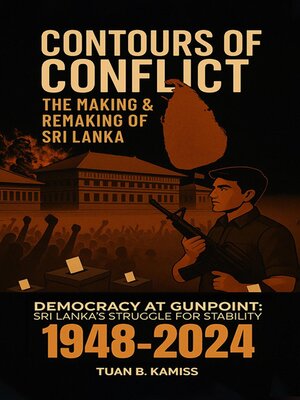
Sign up to save your library
With an OverDrive account, you can save your favorite libraries for at-a-glance information about availability. Find out more about OverDrive accounts.
Find this title in Libby, the library reading app by OverDrive.



Search for a digital library with this title
Title found at these libraries:
| Library Name | Distance |
|---|---|
| Loading... |
Contours of Conflict: The Making & Remaking of Sri Lanka - Democracy at Gunpoint (1948-2024) by Tuan B. Kamiss is a sweeping, evocative, and deeply personal chronicle that captures the turbulent journey of a nation wrestling with the promises and perils of democracy. More than a conventional history book, it stands as part memoir, part political exposé, and part meditation on identity and justice. Kamiss weaves together rigorous analysis, lived experience, and narrative storytelling to illuminate how Sri Lanka's democratic experiment has often been undermined by authoritarian impulses, ethno-nationalist politics, and cycles of violence.
The book stretches across seven and a half decades, beginning with the euphoric moment of independence in 1948, when the island stepped onto the world stage as a dominion of the British Commonwealth, seemingly poised for unity and prosperity. Kamiss charts how those early promises were swiftly eclipsed by structural inequalities and polarizing policies that reshaped the national landscape. The author unpacks critical turning points such as the 1953 Hartal uprising that revealed the gulf between political elites and working-class realities, and the fateful 1956 "Sinhala Only" Act that entrenched linguistic and ethnic divisions in law and practice. These were not mere policy shifts, Kamiss argues, but seismic cultural ruptures that altered the fabric of Sri Lankan society for generations to come.
Through the decades, the book tracks the island's oscillation between fragile democracy and violent upheaval. The rise of Sinhala-Buddhist nationalism, the marginalization of Tamil and Muslim minorities, and the institutional failures that allowed these grievances to fester form a recurring backdrop. The JVP youth insurrections of the 1970s and 1980s, the devastating three-decade civil war against the LTTE, and the pervasive culture of disappearances, censorship, and fear are examined not just as political events, but as lived traumas. Kamiss's own perspective-at times that of a witness, at others of a participant-infuses the narrative with urgency and authenticity.
What sets this work apart is its refusal to reduce history to leaders and battles alone. Kamiss writes with a human-centered lens, foregrounding how ordinary people endured, resisted, or were crushed under the weight of policy decisions and militarized governance. The experiences of marginalized communities-Tamil, Muslim, and Malay in particular-are carefully interwoven, giving voice to those often erased from dominant nationalist narratives. The book recalls stories of schools segregated by language, temples burned in riots, mosques targeted in waves of majoritarian anger, and entire villages scarred by war. Kamiss highlights that democracy, when weaponized by majoritarianism, can become as oppressive as dictatorship.
Ultimately, the book is not just about the past-it is a reflection on the present and a challenge to the future. Kamiss frames the narrative as both a warning and a plea: a warning about the corrosive cost of silence and complicity, and a plea to the younger generations to reclaim Sri Lanka's pluralist promise. The story of Sri Lanka, he contends, is neither linear nor complete. It is one of remaking and unmaking, of fragile hopes and deep wounds, but also of possibilities yet to be realized.
Contours of Conflict: The Making & Remaking of Sri Lanka - Democracy at Gunpoint (1948-2024) is, in the end, a powerful meditation on democracy itself-how it can be betrayed, how it can survive under siege, and how it might still be renewed. It invites its readers, especially the youth, to engage not as passive observers of history,...







